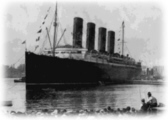Finders KeepersHow to decide who owns what or whether a wreck has been abandoned? The subject has already been at the heart of several big legal battles. It is undisputed that states have control over wrecks and sites found in their territorial waters and many exercise it. But this does not mean the state can claim ownership. Where the state is not involved – in international waters for example – the owner of a wreck may prohibit work on the site or claim any artefacts raised. But who is the owner? Consider the S.S. Central America which sank in 1857 some 160 miles off the South Carolina coast (U.S.A.) with its cargo of gold bullion, then worth a million dollars. She lay at a depth of about 2.4 kms. The remains were located in 1988 by Columbus-America Discovery Group which raised a number of artefacts and a large quantity of gold. Action by the Group in American courts to be declared the owner of the gold was opposed by some 31 British and American insurance organizations who argued they had paid claims made by the owners at the time of the sinking. The court upheld this, even though the documentation was minimal – much having disappeared or been destroyed over the years. AbandonedOne question in that case was whether the insurance companies had abandoned their property. The US court held that they had not, taking the view that abandonment can only be shown by an express statement by the owner to that effect. Columbus-America were thus salvors. The court held that they should get 92.7% on the sale of the insured gold and could keep all the other gold and artefacts.
For over 100 years the insurers had done nothing to recover the gold. For some, that in itself would constitute abandonment even though for most of that time the technology did not exist to reach the wreck. In the case of the Lusitania a British Court held that the contents of this famous wreck had been abandoned following 67 years with no attempt at recovery. Spain has never enforced title to the wrecks of its treasure fleets in the Caribbean or the Armada wrecks of 1588. But The Netherlands claims, as successor in title, all wrecks of vessels that belonged to the Vereenigde Oostindische Compagnie (VOC, i.e. the Dutch East India Company). This became a matter of issue in Norway in the early 1970s following the discovery of gold and silver coins from the Akerendam, which sank off Runde Island in 1725. The government of The Netherlands claimed it still had title to the wreck and eventually a negotiated settlement resulted in it getting 10% of the coins. The same issue arose when the remains of VOC ships were found off Western Australia. The Australian government considered that the passage of 300 years or so without any attempt to locate the vessels constituted abandonment. The Netherlands disagreed. The issue was resolved by the 1972 Agreement between Australia and The Netherlands Concerning Old Dutch Shipwrecks. Under this, The Netherlands transferred "all its right, title and interest in and to wrecked vessels of the V.O.C. lying on or off the coast of the state of Western Australia and in and to any articles thereof to Australia". An annex to the Agreement provides for distribution of excavated material and its reassembly if necessary for research. These issues disappear as one goes further back in time. It is unlikely that an owner will come forward for a Phoenician galley! But there can be other problems, particularly if the wreck lies outside territorial waters or another zone which a state claims to control (for example, Australia and Ireland claim control of wrecks on their continental shelves). What happens if two groups of excavators claim to have discovered the site and both want to work on it independently? One or both groups could go to a court and ask to be declared the owner of any artefacts raised from the site. For example, a court in Virginia has conferred salvor-in-possession status of the Titanic to R.M.S. Titanic Inc. – an American corporation – and granted it exclusive rights over any artefacts it raises from the wreck even though the wreck itself is hundreds of miles from the territory of the United States of America. In spite of this decision, the corporation could have difficulty keeping persons having no contact with the United States from the site. WarshipsMany states claim sovereign immunity for their warships, military aircraft and associated artefacts. Broadly, this means that permission of the flag state should be sought before any activity takes place affecting the site, even if it lies in the waters of another state. This raises a number of issues. For example, how far back in time does it extend and what exactly is a warship? Up until 1856, privateers – private vessels commissioned by letters of marque and reprisal to seize enemy ships and cargo – often supplemented conventional naval forces. It is not known how a claim to sovereign immunity for the wreck of such a vessel would be met. The issues discussed above make it difficult to foresee how a wreck site will be treated so as to preserve the information contained in it and the artefacts not of commercial value. Those drafting an international convention on the subject will need to consider such matters. Patrick O'Keefe Consultant in cultural heritage law and management Published in UNESCO Sources, February 1997 published on Nordic Underwater Archaeology |

 Back to Nordic Underwater Archaeology
Back to Nordic Underwater Archaeology